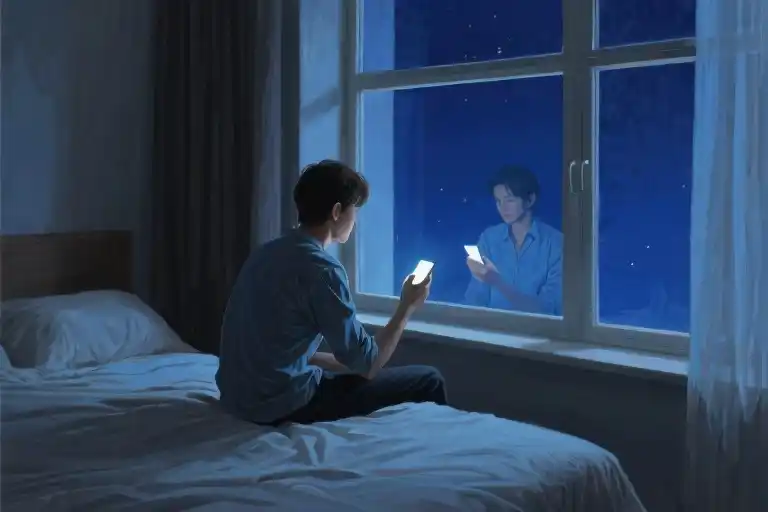The notification pops up.
A last message that seals the ending.
Your best friend’s contact now labeled ‘maybe: don’t text’.
Plans dissolving like sugar in cold coffee.
That dream you nurtured for years—gone without explanation.
It happens when you did everything right.
No amount of precautions can vaccine you against these moments. They arrive unannounced, unpack their bags in your chest, and refuse to discuss checkout dates.
Mornings sometimes grant temporary amnesia. You open your eyes and for three sacred seconds, the weight isn’t yours to carry. Then remembrance comes rushing back like tide reclaiming sandcastles.
What nobody prepares you for isn’t the pain—it’s the ordinary acts that follow. Brushing your teeth while grief sits on the bathroom counter. Answering work emails with invisible bruises. Cooking single-portion meals in pans meant for two.
These aren’t signs of healing. They’re something far more powerful: daily rebellions against the void. Each mundane action a quiet ‘I’m still here’ carved into the darkness. Not moving on, but moving through—one stubborn step at a time.
The Unrevocable Collapse
There are losses that refuse to be undone, no matter how many times you press Ctrl+Z on the keyboard of your life. The message thread that now ends with your unanswered text. The shared project folder suddenly stripped of edit access. The birthday reminder for someone who no longer knows your middle name.
Medical anthropologists call these “non-growth traumas”—wounds that don’t conform to the neat narrative of post-traumatic growth. A Johns Hopkins study found 23% of significant life disruptions yield no measurable personal development, just a quiet reshuffling of pain. The body keeps score differently: elevated cortisol levels during routine tasks, micro-sleep disturbances when reaching for a phantom phone notification.
I once met a woman who preserved a three-year string of blank chat history like a museum exhibit. “It’s not hope,” she explained. “It’s proof I didn’t imagine the 1,147 messages that used to be there.” Her phone had become both tombstone and witness, the empty space between timestamps louder than any notification tone.
These are the fractures that won’t fuse stronger at the break:
- Relational amputation: When trust dissolves faster than bloodstains on concrete
- Opportunity necrosis: Dead dreams that resist the CPR of positive thinking
- Identity vertigo: The dizzying realization you’ve been building on someone else’s blueprint
The peculiar agony lies in their simultaneity—you mourn multiple versions at once. The future that won’t happen, the past that now reads differently, the present you don’t recognize in mirrors. Like trying to solve a jigsaw puzzle where someone keeps swapping the reference image.
Yet here’s what the research won’t tell you: there’s an unexpected dignity in refusing to call this “healing.” To simply say “This happened” without appending “for a reason.” To let the scar tissue form its own topography, even if it means always walking with a slight limp.
The Toxicity of “Time Heals”
We’ve all heard it – that well-meaning phrase tossed our way after loss. “Give it time,” they say with a pat on the shoulder, as if grief operates on some predictable expiration date. But here’s what nobody admits: time doesn’t heal. It simply teaches us to carry the weight differently.
This cultural obsession with healing timelines isn’t compassion – it’s emotional capitalism. We’ve commodified recovery, demanding that pain must produce personal growth to be valid. Your suffering should make you wiser, stronger, more enlightened. Otherwise, what’s the point? This unspoken expectation creates what psychologists call secondary wounding – the shame we feel when our grief outlasts society’s acceptable mourning period.
Consider the three most common “comforting” lies:
- “You’ll get over it” – implying your love was disposable
- “Everything happens for a reason” – erasing the randomness of tragedy
- “At least…” – the comparative suffering Olympics
These aren’t bridges back to life – they’re dismissal dressed as wisdom. Real support sounds different: “This sucks. I’m here. Want to sit with it together?”
The Emotional Industrial Complex
We’ve created an entire economy around “fixing” broken people. Productivity culture sneaks into our grief: How many self-help books have you consumed? How many therapy sessions before you’re “better”? We track recovery like quarterly earnings, frustrated when our emotional ROI disappoints.
Here’s your permission slip: Stop treating your heart like a startup. Some losses become part of your cellular makeup. That email you’ll never send, that anniversary date that still catches in your throat – these aren’t failures to heal. They’re evidence you loved something real.
Your Turn:
In the margins of this page (or in your mind), write down the most unhelpful “comfort” you’ve received. Now cross it out. That act alone is a tiny rebellion against the healing industrial complex.
What makes these platitudes so dangerous isn’t their falseness – it’s how they isolate. When we imply pain should have an endpoint, we force grievers into solitude when their timeline “expires.” The truth? Most of us are learning to dance with our ghosts, not exorcise them.
Tomorrow morning, when you brush your teeth and the weight returns, remember: You’re not behind schedule. You’re not failing at recovery. You’re practicing the ancient art of carrying what can’t be left behind.
The Rebel’s Checklist
There’s an unspoken algorithm to survival. Not the kind that solves problems or undoes damage, but the sort that quietly recalculates your center of gravity when the floor disappears beneath you. This is the mathematics of micro-rebellions—those small, stubborn acts that rewrite the rules when life insists you’ve been disqualified.
Consider Churchill’s wartime naps. While London burned, the prime minister religiously took his afternoon sleep. Not because rest made strategic sense (his generals protested the schedule), but because maintaining this tiny personal ritual became his psychological air raid shelter. The rebellion wasn’t in the sleeping—it was in refusing to let crisis dictate every aspect of being. His body’s need for rest became a quiet mutiny against circumstance.
We each have our version of this algorithm running. Yours might look like:
when (grief > tolerance) {
execute(routine_action); // Brushing teeth becomes civil disobedience
if (resistance < critical) {
deploy(emergency_ritual); // The playlist, the walk, the specific coffee mug
}
}These aren’t coping mechanisms in the traditional sense. Coping suggests adaptation to circumstance, while micro-rebellions insist circumstance adapt to you—even if only in symbolic ways. That’s why they work when nothing else does: they preserve agency at molecular levels.
Three characteristics define true micro-rebellions:
- They’re intentionally trivial – Folding one dish towel when the sink overflows. Making your bed while ignoring unopened legal documents. The smaller the action, the sharper the defiance.
- They reject productivity – These aren’t steps toward healing or self-improvement. The act exists purely as a declaration: I still decide something.
- They’re slightly irrational – Like wearing mismatched socks to a funeral or eating dessert first during bankruptcy proceedings. The logic exists outside conventional wisdom.
Your rebellion inventory might include:
- Continuing to water a dead plant
- Wearing ‘nice’ pajamas for Zoom calls with creditors
- Keeping the 3:15pm tea ritual even during hospital vigils
The template isn’t about what you do—it’s about what the doing means. Below this line, write one micro-rebellion you’ve performed this week:
What makes these acts revolutionary isn’t their visibility, but their invisibility. No one awards medals for maintaining a skincare routine during depression, yet these private insurrections often determine whether we collapse or continue. They’re the underground resistance of the soul.
Notice how your filled-in blank above carries more emotional weight than any generic self-care advice ever could? That’s the algorithm working. The action itself matters less than your conscious recognition of it as rebellion—a personal semaphore flag signaling I’m still here to whatever part of you remains on watch.
Tomorrow’s assignment: perform one completely pointless act with deliberate ceremonialism. Not to feel better. Not to achieve anything. Simply because you still can.
The Quiet Rebellion of Continuing
That message still sits in your drafts folder. The friend’s contact name now carries an invisible asterisk. The plan you sketched on napkins has yellowed at the edges. These things don’t get erased—they become landmarks in a geography you never meant to navigate.
What they don’t tell you about resilience is how it looks nothing like victory. It’s not the raised fist, but the hand that picks up the toothbrush anyway. Not the triumphant speech, but the voice that says ‘I’ll take that call’ when every cell screams to hide. Rebellion wears the disguise of ordinary things: tying shoelaces, paying bills, watering the plant that outlived your optimism.
Three ways to read your survival map differently:
1. The Archaeology of Small Defiances
Your coffee mug rings on the desk form a timeline. Each faint stain marks a morning you chose presence over paralysis. Psychologists call this ‘behavioral activation’—you call it getting through the damn day. These aren’t compromises, but covert operations against despair.
2. The Grammar of Unfinished Business
That unsent message? It’s now a semicolon rather than a period. Most rebellions don’t conclude with fireworks; they whisper through run-on sentences of daily living. The French resistance had their petits papiers—you have Post-its with grocery lists written over old dreams.
3. The Physics of Persistent Matter
Newton was half-right: bodies in motion tend to stay in motion, even when the heart wants to play dead. Your rebellion has a half-life no one can calculate. When you heat leftovers instead of starving the pain, you’re proving Einstein wrong—some energy doesn’t convert or disappear.
At the bottom of this page, smaller than a regret:
‘You’ve been in resistance mode for [_] minutes’





